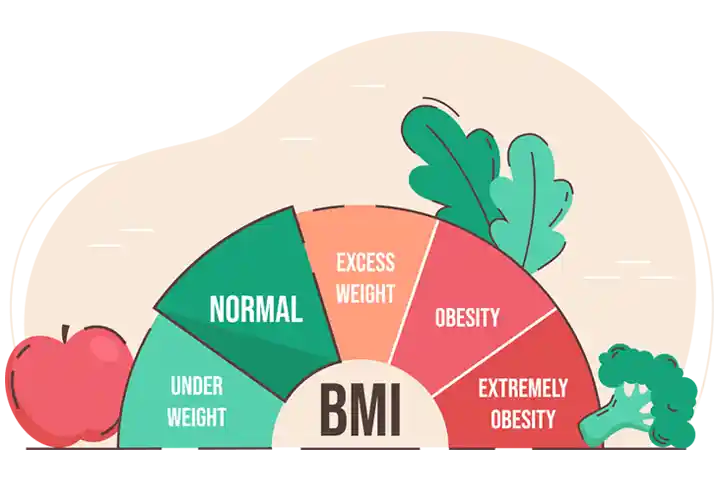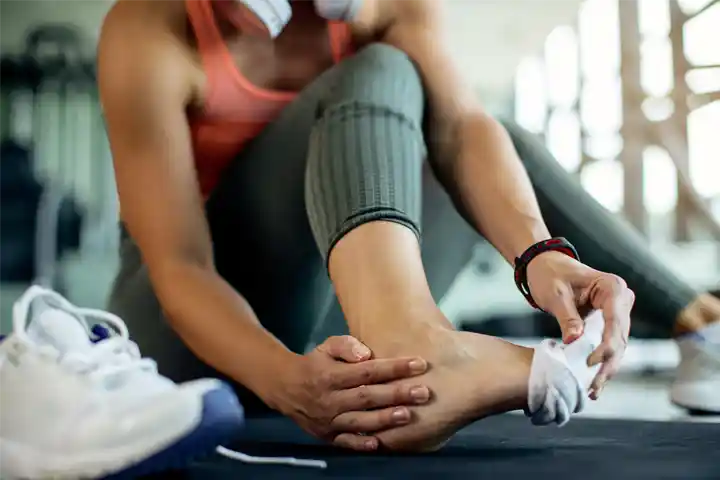Negative Side Effects of Rebounding: Who Should Avoid It?
Disclaimer: This website exists thanks to you, the readers. When you buy through links on my site, I may earn an affiliate commission.
Rebounding has become very popular in recent years. And after you’ve looked into the benefits, it’s only natural to start asking about the negative side effects of rebounding.
Just like with any workout regimen, it's essential to consider the flip side of rebounding exercise. In this article, we'll dive into the lesser-known aspects of rebounding – its potential drawbacks.
Whether you're a fitness enthusiast or just considering adding a mini trampoline to your routine, it's important to be informed about who might need to take a step back from this high-energy activity.
So, are there any cons of rebounding? Can it be dangerous to certain groups of people?
Yes, of course, there are potential negative side effects if you don’t pay enough attention to a few things that we’ll discuss below.
Who should be careful when using a rebounder?
Rebounding is a low-impact exercise that can provide various health benefits for people from different social categories. But like any other sport, there might still be some risks involved.
Some groups of people are at a higher risk of experiencing negative side effects during rebounding. Here’s what you need to keep in mind:
Weight and Body Mass Index (BMI)

Individuals who are overweight or have a higher BMI may be at a higher risk of experiencing negative side effects during rebounding.
Higher weight places more stress on the joints, and this can lead to injuries. People who are overweight are more likely to experience knee issues. Dr. Joey Johnson, orthopedic trauma fellow at the Warren Alpert Medical School of Brown University and a physician at Rhode Island Hospital, says:
“As the rate of obesity increases, the rate of knee dislocations increases.”
Being overweight might also lead to having varicose veins. If you have this condition, you should avoid rebounding. This is because jumping on the trampoline causes more pressure on the body against gravity and that might worsen varicose veins in overweight people.
But there is good news, too! if you don’t have these medical conditions, rebounding can help you lose weight.
Fitness Level
You know how it goes. If you don’t know anything about running and you push yourself to run 5 miles, you are likely to get injured. It’s the same with rebounding.
If you’re new to rebounding or have a low fitness level, you may experience injuries due to a lack of proper technique and conditioning. That’s why, if you’ve decided to begin practicing rebound exercise, I’d recommend starting slowly and gradually increasing the intensity and duration of your rebounding sessions.
Also, don’t try any tricks on the mini trampoline!
Medical Conditions
Individuals with certain medical conditions may be more likely to experience negative side effects during rebounding. Conditions such as osteoporosis, arthritis, and heart disease can increase the risk of injury or exacerbate symptoms.
If you have a serious medical condition, physical trauma, or musculoskeletal issues, you should consult with a healthcare professional before starting any new exercise program, including rebounding.
What Are the Negative Side Effects of Rebounding
Here is a summary table for your reference:
Group | Potential Risks | Injury Types | Precautions |
|---|---|---|---|
Overweight/ | Higher injury risk | Joint injuries, Varicose veins | Consult doctor before starting |
Low Fitness Level | Technique-related injuries | Sprains, Fractures | Start slowly, avoid tricks |
Medical Conditions (osteoporosis, arthritis, heart disease) | Increased injury risk | Exacerbation of symptoms | Seek medical advice first |
Seniors | Balance, bone density issues | Lower extremity injuries | Gentle, low-intensity sessions |
Scoliosis Patients | Spinal stress | Worsening of spinal curvature | Avoid if painful or consult a doctor |
Degenerative Disc Disease | Spinal stress | Increased back and neck pain | Consult a doctor, focus on posture |
Varicose Veins | Increased pressure on legs | Worsening of condition | Consult a doctor before starting |
Neck Issues | Pressure on spine | Aggravation of existing conditions | Seek medical advice, focus on low-intensity |
Lymphedema | Pressure on lymphatic system | Swelling, discomfort | Moderate intensity, consult doctor |
Pelvic Floor Issues | Stress on pelvic muscles | Incontinence, weakening of muscles | Consult doctor, gentle exercises |
Read on to find out more.
What are the most common injuries?
A recent study in Switzerland found the most common injuries were in the lower part of the body, usually involving the feet, ankles, and knees. This is no surprise, considering that rebounding means jumping on a mini trampoline.
Is Rebounding Bad for Your Back?

For people with minor back issues, rebounding might actually be helpful because it may improve bone density and strengthen the muscles.
On the downside, there is evidence of people experiencing a condition called Vertebral Compression Fracture (VCF) because of bad posture during rebounding.
Rebounding does involve a combination of compression and decompression of the spine due to the gravitational changes when jumping and landing. This could theoretically exert pressure on the spinal discs, particularly if they are already weakened or compromised due to conditions like disc herniation, degenerative disc disease, or other spinal issues.
It is worth noting that other forms of exercise also exert this type of pressure on your back.
If you suffer from any serious back injury or spine problem, you might want to be careful with your rebound trampoline workouts (or any workouts, for that matter). In such cases, it’s best to consult a doctor or a physiotherapist and focus on low-intensity sessions.
Is Rebounding Bad for Seniors?
A recent study confirmed that rebounding is generally beneficial for people as their age advances, especially women. The paper says:
“Mini-trampoline jumping is a highly beneficial low-impact aerobic exercise capable of improving aerobic fitness, balance, muscle strength, and potentially bone health as well as pelvic floor muscle functioning.”

However, it is worth noting that, as people age, their bodies change. According to Medline Plus, seniors are prone to losing bone mass or density, experiencing a decrease in lean body mass, and losing balance more easily.
This means that, while there are numerous benefits of rebounding for seniors, older adults should approach it cautiously, keeping these age-related changes in mind.
Be honest about your individual health and physical limitations before starting any kind of sport. And always be gentle on your body. Exercise is not a competition!
Is Rebounding Bad for Scoliosis?
Scoliosis might be due to genetics, but it can also be acquired. In its core, it's a deformation in the spinal column, caused by putting an uneven pressure on one side of the spine compared to the other.

An article by ScoliSmart suggests that people with lumbar-type scoliosis should avoid trampoline jumping due to the risk of the downward landing force on the spine exacerbating the condition. It also says that trampolining, in general, may be risky for those with nerve damage or pinched nerves.
So far, there is no certain result in studies that can prove whether rebounding effects for people with scoliosis are positive or negative. The National Scoliosis Foundation advises that people with this condition should avoid anything that causes pain or worsens their already existing symptoms.
Is Rebounding Bad for Degenerative Disc Disease?
Degenerative disc disease is basically a wearing down of the spinal discs over time. It may result in back and neck pain. Some people think that any sport would help improve this condition, but it may actually get worse by certain activities. According to Dr. Hooman Melamed, FAAOS, the top worst sports for spine injuries are:
- Cheerleading
- Diving
- Football
- Horseback riding
- Rugby
- Skiing
- Snowboarding
- Wrestling
However, this doesn’t mean that you should avoid sports altogether. On the contrary, it’s a very good idea to become more regular with that.
Medical News Today says:
“Exercise is frequently a more effective nonsurgical treatment than resting for rehabilitating the spine.”
What about rebounding and degenerative disc disease? Bouncing on the mini-trampoline puts some pressure on the spinal discs. However, when compared to other sports, such as running, rebounding definitely has some undebatable pros.
Of course, it’s always better to first consult a professional before starting a new fitness activity. Also, don’t forget to do a good warm-up at the beginning of your rebounding session. Watch out for the proper posture of your back and make sure you use comfortable shoes for sports.
Is Rebounding Bad for Ankles?
When it comes to rebounding and ankles, there are a few things to consider. First of all, when you’re doing anything that involves jumping or running, the ankles experience quite a lot of stress. That’s because of the pressure that’s put on the body at the moment of landing.

In that sense, rebounding is much safer than running because you land on an elastic surface. It absorbs some portion of the impact force, so there is less pressure on the ankles.
However, if you already have health problems in your joints, even rebounding might not be safe enough. Something to consider to avoid injuries and negative side effects of rebounding is to choose the right rebounder for your needs. Quality equals safety. The better the material and mechanism of the equipment, the less you have to worry.
Is Rebounding Bad for Knees?
Rebounding itself is not bad for people with healthy knees. However, if you have suffered a knee injury, for example, it may be better to avoid rebounding.
To get a bit more scientific, this is because trampoline jumping, research suggests, has a greater knee extensor moment compared to hard surface jumping. This means that the muscles responsible for straightening the knee work harder during trampoline jumping than when jumping on a hard surface. The muscles, not the joints. So, this is one of those rebounding myths. Jumping on a mini trampoline could be great for strengthening these muscles when you are healthy. But it might also be a concern for those with existing knee issues.
As we mentioned in the previous paragraph, your joints take all the weight when landing, even on a rebounder, so your knees are doing most of the work. That’s why your posture is vital to keep you safe. Make sure you bend your knees when landing so you can avoid overusing the knee muscles and joints.
Is Rebounding Bad for Varicose Veins?
Varicose veins are a condition in which you lack elasticity within the walls of the veins, so when more blood passes through them, it causes the veins to become varicose. It is often caused by being overweight, lifting heavy things, suffering an injury, or advanced age.
If you are at a high risk or if you already experience varicose veins, then you should think twice before starting to practice rebounding. Even though it’s a low-intensity workout, jumping on a rebounder puts pressure on the legs.
It’s worth mentioning, however, that if you’ve consulted a doctor and you are reassured you’re not in a risk category, studies suggest that rebounding should be perfectly fine for you to practice.
Dr. Rahul Sood, DOO, R.Ph. says:
“Regular rebounding really enhances blood flow, preventing blood from pooling in our veins.”
Is Rebounding Bad for Someone with Neck Issues?
Neck pain is a common musculoskeletal complaint, affecting 30-50% of the population annually, with two-thirds experiencing it at some point in their lives.

Rebounding is considered a form of low-impact exercise, but it does put pressure on your back and neck. Especially on the soft tissues (the discs) between the vertebrae. For people who already have neck issues, it’s better to first consult a professional before considering rebound workouts.
Dr. Guy Ashburner, Osteopath, D.P.O., BSc. (Hons), says:
“Repetitive compression of the spine by bouncing up and down on a trampoline can lead to back pain and may aggravate existing back pain due to the increase in disc pressures and these joints are overstretched causing injury, inflammation and spasm of surrounding soft tissues.”
And Dr. Michele LaBotz of the AAP says:
“Head and neck injuries most often result from a failed flip or air-borne somersault on the trampoline.”
However, I must add that they may also occur during a fitness routine if you happen to fall off the trampoline.
Is Rebounding Bad for Lymphedema?
Lymphedema is damage in the lymphatic system, or more specifically, a build-up of lymph fluid in the lymph tissues, which leads to swelling.
Some consider rebounding helpful for people in that condition, because it helps lymph circulation, but the workout intensity should always be kept between 50-60% of your actual capability.
As mentioned before, you should always consult a doctor before starting any sports activity if you have any physical health issues.
Is Rebounding Bad For Your Bladder?
In general, rebounding isn’t bad for your bladder if you don’t have any health issues in that area.
However, there are people who have personal risk factors to consider before trying rebound workouts. These are:
- women who have given birth recently
- people who have experienced abdominal surgery
- people with a weak pelvic floor
- people with urinary tract problems
The reason is these groups may experience urinal incontinence or, in other words, they can’t fully control their bladder.
In that situation, you can encounter negative side effects of rebounding, and it might not be the best sport to practice. That’s because the bouncing increases bladder movement. It brings extra pressure on the pelvic floor, which can no longer support the weight of the bladder, and the result is often unplanned urination.
Still, if you keep your workouts at a very low intensity, it might be OK.
Is Rebounding Bad for the Pelvic Floor?
The pelvic floor is a group of muscles that support the bladder, rectum, and uterus. The condition of the pelvic floor depends on a few individual factors.
Generally speaking, if you don’t have health problems in that area, rebounding is completely okay and it’s even helpful to maintain the strength of the pelvic floor.
In most cases, problems with the pelvic floor occur in women after childbirth. Still, some men might also experience similar conditions. In such cases, rebounding can cause damage to the pelvic floor, because it can weaken these muscles even more and cause further problems like incontinence.
It’s worth noting that there isn’t a yes/no answer to this question, as with all questions on this list. The Australian Continence Foundation says:
“Your risk of pelvic floor injury with rebounding depends on both a) the impact of your rebounding exercises and b) your individual risk factors.”
If you’ve discussed your pelvic floor health with a doctor and decided to practice rebounding workouts, then a pro tip from us is to try landing on one leg to reduce the chance of pelvic floor injuries. Also, make sure to avoid overdoing your workouts.
Is Rebounding Bad for Prolapse?
Prolapse is the condition in which organs of the pelvis slip down from their initial position. This may be caused by childbirth, obesity, aging, etc.
That being said, rebounding is jumping. It is a physical activity and this means it might either improve or deteriorate your health, depending on your individual condition.
Basically, if you’re in good health, you’ll most likely experience the positive effects of rebounding. Bouncing up and down helps strengthen the muscles of the pelvic floor which means it can help prevent prolapse.
However, if you are at risk of prolapse or if you’ve already suffered one, then it’s better to avoid rebounding so you don't worsen the problem. Considering that even healthy professional trampolinists can experience incontinence after very long and intensive sessions, it’s probably not a good idea to rebound with prolapse.
Is Rebounding Bad for Back Muscle Imbalances?
A back muscle imbalance occurs when the muscles in the back are not equally developed or are not functioning properly in relation to each other. This can happen for various reasons, including incorrect training, sitting all day, and sports injuries.
If you’re in good health and you have the right workout technique, rebounding can be a great way to strengthen your muscles. It can even help you prevent or treat back problems. A small study suggests that mini trampoline jumping may actually be effective in reducing back asymmetry.
But let’s get back to our previous point – sports injuries and improper training. Like any sport, rebounding may cause injuries when not performed properly. Try to keep your body straight and try not to bounce too hard (this puts extra pressure on your muscles and your spine when landing on the surface).
If you already have back problems or if you’ve suffered some injury in the past, consult a health professional first.
But most importantly – listen to your body. Be gentle with your body when you’re doing any form of exercise.
Is Rebounding Bad for High Blood Pressure (Hypertension)?
Hypertension or high blood pressure is a very serious concern in today’s modern world. It’s even nicknamed by doctors “the silent killer” because it’s difficult to diagnose and can cause heart disease, kidney disease, or even a stroke.

If you have that condition, pay extra attention before you start doing sports. Blood pressure does rise during exercise, a study says:
”Normally, blood pressure rises during exercise due to increased cardiovascular demand and oxygen uptake from working muscles”
This doesn’t mean people with hypertension can’t exercise. However, they should be careful. The American Heart Association says:
“Scientific evidence strongly shows that physical activity is safe for almost everyone. Moreover, the health benefits of physical activity far outweigh the risks.”
That being said, if you have hypertension, you should consult your physician before starting any fitness routine, including rebounding. It may be that you need less vigorous forms of exercise. That is possible with a rebounder because you can do slow, light jumps and avoid high-intensity rebounding workouts.
And if you don’t already have hypertension, rebounding, like other sports, might be very helpful in avoiding such problems. It stimulates the lymphatic system, clears toxins in the body, and may help lower blood pressure.
Is Rebounding Bad for Nerve Damage?
Nerve-related issues can vary greatly. It really depends on what your condition is. If it’s related to a trauma of the spine or back, rebounding may be an acceptable choice. In sports like running or rope skipping, for example, the action of landing on hard ground requires healthy legs and spine. With rebounding, the elastic surface of the mini-trampoline helps a lot in avoiding traumas in these areas.
Still, for people who suffer nerve damage, even light jumping may not be recommended. For example, the American Diabetes Association recommends that people with peripheral neuropathy exercise caution when doing “high-impact, strenuous, or prolonged weight-bearing activities such as walking a long distance, running on a treadmill, jumping/hopping.”
It really depends on your condition. Please consult your physician because you may experience negative side effects of rebounding. If they do not recommend jumping, try some even more low-impact activities like walking to make sure you don’t make your situation worse.
At the same time, studies show that jumping on a mini-trampoline can improve mobility and increase walking speed for people with neurological disorders. But don’t start before talking to a health professional.
Safety rules for trampolining on a rebounder
Safety should be your top priority when rebounding. In this section, you’ll find the essential prevention and safety tips to follow when rebounding.
Check your equipment
To prevent accidents and injuries, you need quality equipment that you take good care of. Here is what to do:
- Find the right rebounder for your individual needs, your level of preparation, and your goals. The same goes for the shoes – usе footwear with good traction to prevent slipping and falling.
- Inspect your rebounder before each use to ensure that all parts are in good condition and there are no loose or damaged parts.
- Check if the rebounder is placed on a stable surface and is not wobbly. This is crucial if you’re a beginner and you haven’t improved your balance and body-to-surface coordination yet.
- Keep the area around the rebounder free from clutter. It’s rare for adults to fall but you’d want to avoid those hazards.
Maintain good form
If you want to avoid injuries and fully enjoy your rebounding sessions, pay attention to your posture, your bouncing technique, and your overall health condition. Here are some tips for proper form and technique to help you avoid any negative side effects of rebounding:
- Always start by warming up so you can prepare your body for the workout.
- Keep your feet shoulder-width apart and your knees slightly bent to avoid putting too much stress on your ankles and knees when landing.
- As with any other sport, make sure you don’t overdo it and you don’t overburden your body.
- Start slowly if you’re a beginner and increase the intensity gradually as you upgrade your fitness level.
Listen to your body
Pay attention to how your body feels during and after the workout, and adjust your workout accordingly. Stop immediately if you feel pain or discomfort, and seek medical help if the pain persists.
A must-do for people who have suffered significant injuries of any kind is to ask for professional medical advice prior to starting a rebounding workout.
FAQ
Should you consult a doctor before rebounding?
If you're thinking about adding rebounding to your fitness routine, it's always a good idea to consult your doctor before starting. While rebounding can be a low-impact form of exercise, it may not be suitable for individuals with certain medical conditions or physical limitations.
Is it OK to rebound every day?
Generally, it’s safe to rebound for as long as you're not overdoing it and you’re paying attention to your body's signals. According to a 2018 study, exercising on a mini-trampoline for as few as three days a week can lead to significant benefits.
But generally, make your rebounding sessions as long as it feels good. Start slowly and gradually increase intensity and duration. If you have any concerns or pre-existing medical conditions, it's always best to seek medical advice first.
Can rebounding cause dizziness or nausea?
It’s possible, mostly for people who are new to rebounding, to experience dizziness or nausea. Studies show that, after repeated jumps on a rebounder or a trampoline, you might feel heavy or unable to jump again right after. However, more research is needed to fully understand the motor and sensory effects of jumping on an elastic surface.
Can rebounding cause muscle soreness?
As with many other sports, rebounding can also cause muscle soreness, especially for beginners. This is normal, and it usually only happens during the first few workouts as your body adapts to the new exercise.
If you experience muscle soreness, be gentle with yourself and reduce the duration and intensity of your workouts until the soreness passes. Over time, your muscles will adapt and become stronger, and it will happen less often.
What is the recommended duration and frequency of rebounding sessions?
The recommended duration and frequency of rebounding sessions can vary depending on your fitness level and goals. For beginners, it's best to start with shorter sessions and gradually increase the duration and intensity over time.
Once you're past the beginner stage, we recommend doing a 10-minute rebounding exercise twice a day. According to NASA's study, a 20-minute rebounding session can be as effective as a 30-minute jog, so even short sessions can be beneficial. As you become more comfortable with this sport, it's less likely that you'll experience negative side effects of rebounding. You can then increase the frequency and duration of your sessions to meet your fitness goals.
Can rebounding cause long-term damage to joints?
If you’ve got any joint injuries (and not only), think twice before starting any kind of sport. In case you’re healthy, rebounding is a good option for your body. That’s because it’s easier on the joints than other sports like running, thanks to the elastic surface of the mini trampoline.
Conclusion
Having all the possible negative side effects of rebounding checked, it’s time for a final verdict. As with any sport, there are some potential risks when practicing rebounding.
However, that shouldn’t discourage you at all, because the positive effects are many, too. The important thing is to take precautions, consider your health, consult your doctor, and never overdo it. With that said, rebounding is a great form of workout that has many benefits both for the body and the mind. So, if you recognize the risks and learn how to avoid injuries, you can fully experience the positive sides of rebounding.
When in doubt and when you have a serious health condition, always consult a doctor. Better be safe than sorry!
References & Further Reading
- Rebounding vs. Running: Full Breakdown Backed by Science
- Competitive trampolining influences trabecular bone structure, bone size, and bone strength | Journal of Sport and Health Science
- Trampolining Accidents in an Adult Emergency Department | NCBI
- Can trampolines hurt your spine?
- Does trampoline or hard surface jumping influence lower extremity alignment? | NBCI
- Rebounding to treat varicose veins
- The Relationship Between Neck Pain and Physical Activity
- Rebounding: Good for the lymph system
- Mini-Trampoline Jumping as an Exercise Intervention in Postmenopausal Women | NCBI
- Rebounding and the pelvic floor
- Physical Activity and the Pelvic Floor | NCBI
- Could Mini-Trampoline Training Be Considered as a New Strategy to Reduce Asymmetries? | MDPI
- Exercise-Induced Hypertension in Healthy Individuals and Athletes | NCBI
- Side effects and risks when exercising with diabetes - ADA
- Effects of rebound exercises on balance and mobility of people with neurological disorders | NCBI
- What to look for when buying a rebounder
- The best rebounder exercise trampolines for any budget

